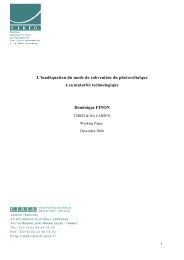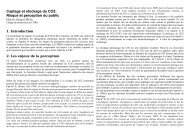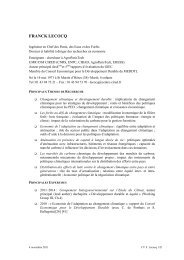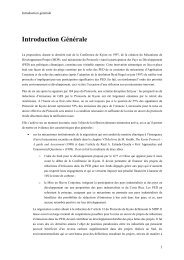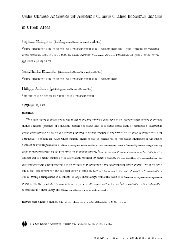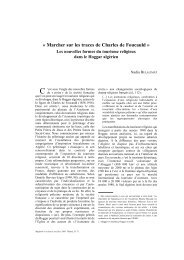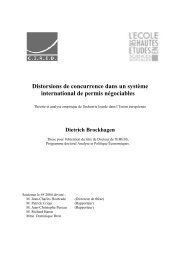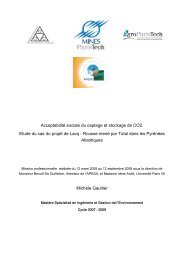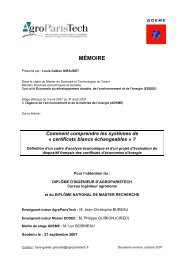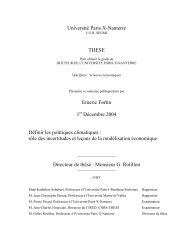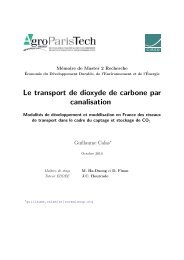Financial, Economic and Distributional Analysis - Centre ...
Financial, Economic and Distributional Analysis - Centre ...
Financial, Economic and Distributional Analysis - Centre ...
You also want an ePaper? Increase the reach of your titles
YUMPU automatically turns print PDFs into web optimized ePapers that Google loves.
<strong>Financial</strong>, <strong>Economic</strong> <strong>and</strong> <strong>Distributional</strong> <strong>Analysis</strong> 94reservoir may be maintained following decommissioning of the power plant or the process of rapidliberalisation of carbon from dead biomass may continue following the draining of the reservoir.Again, other things equal, such considerations may tilt the option value in favour of thermal power.In this fashion the use of a qualitative comparison of these option values for different alternatives forwater <strong>and</strong> resource development could be a useful input into the assessment process. Ideally, thiswould take place early in the assessment of alternatives as a means of identifying the principleirreversibilities <strong>and</strong> uncertainties of the options under consideration. As selected projects proceedthrough to feasibility <strong>and</strong> appraisal the possibility exists of exp<strong>and</strong>ing <strong>and</strong> deepening the qualitativeanalysis. Quantitative methods for looking at these option values do exist. These consist of dynamicprogramming approaches or a contingent claims approach in which the methods developed forvaluing financial options are applied. A growing literature on the latter – the valuation of “real:options – exists. Indeed it is notable that the literature, both qualitative <strong>and</strong> quantitative, includes anumber of innovative applications to the fields of energy, climate <strong>and</strong> forestry fields. However, nosignificant mention of the application of these ideas to dams appears in the literature reviewed for thispaper.7.4 Findings <strong>and</strong> RecommendationsThe application of the theory of investment under uncertainty <strong>and</strong> irreversibility to dams, <strong>and</strong> to waterresources development more generally is novel at this stage. Further investigation is needed todetermine the applicability of these ideas to the project planning <strong>and</strong> evaluation process. Still, itseems likely that at least the insertion of a qualitative discussion <strong>and</strong> analysis of different alternativesin this regard may be useful at an early stage in the screening <strong>and</strong> ranking of projects. Indeed, it ispossible to argue that stakeholder discussion of different scenarios for water <strong>and</strong> energy resourcesdevelopment should include these issues in an explicit fashion, given that they may have significantbearing on the CBA outcomes.In terms of specific areas for further investigation, it would be worth considering the extent to which,in practice, the passage of time is likely to significantly reduce the uncertainty about future values ofthe irreversible investments <strong>and</strong> divestitures associated with different options, particularly theenvironmental <strong>and</strong> social impacts. Attention should examine how the costs <strong>and</strong> benefits ofinvestments may differ in terms of irreversibility, uncertainty <strong>and</strong> timing. The objective here would beto see if the different components of the alternatives under consideration are likely to have the samecharacteristics in this regard <strong>and</strong>, thus, can be bypassed or whether important differences betweenalternatives are expected <strong>and</strong> should be accounted for in the decision process.Pending efforts to apply the quantitative methods available to dams <strong>and</strong> their alternatives, this remainsan area for ongoing strategic thinking <strong>and</strong> research, particularly given that there is an emergingliterature pointing the way.This is a working paper prepared for the World Commission on Dams as part of its information gathering activities. The views, conclusions,<strong>and</strong> recommendations contained in the working paper are not to be taken to represent the views of the Commission



